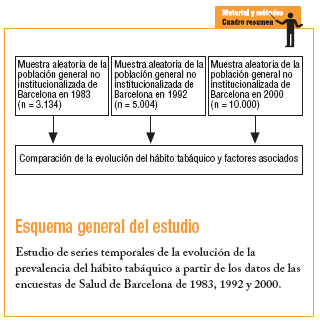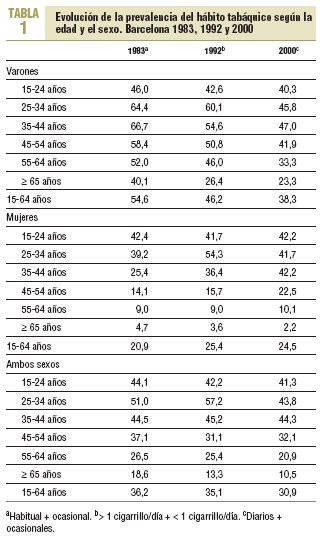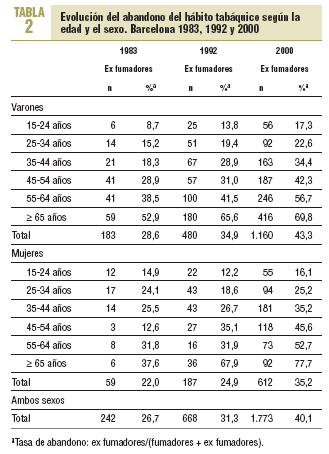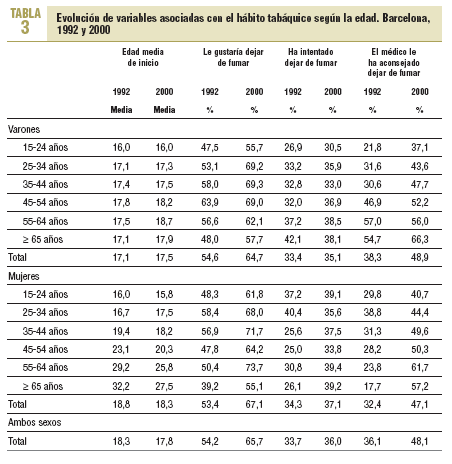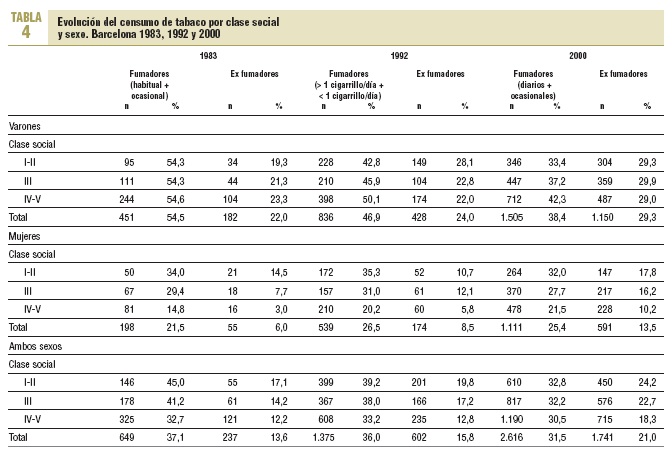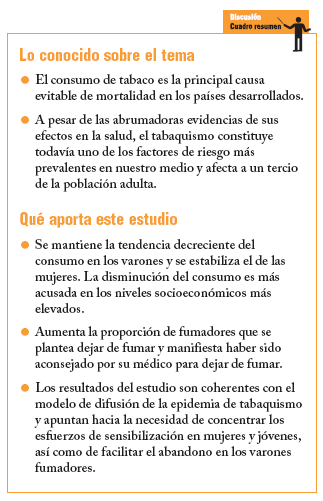to 2000. Design. Time series study. Setting. Health survey based on home interviews of a representative sample of the general population of Barcelona. Participants. In the years 1983, 1992, and 2000 we interviewed 3134, 5004, and 10 000 persons, respectively. Main outcome measures and results. Between 1983 and 2000 daily tobacco use showed a steady tendency to decrease among men, with a prevalence that decreased from 54.6% to 38.3%, while in women, smoking increased between 1983 and 1992 (from 20.9% to 25.4%) but remained stable in 2000 (24.5%). The proportion of smokers who said they wanted to quit increased in both sexes from 1992 (54.2%) to 2000 (65.7%). During this period the proportion of smokers who said their doctor had advised them to quit increased from 36.1% to 48.1%. The trends for both sexes showed that consumption of tobacco products was greater among less privileged socioeconomic groups. Conclusions. The results of this study confirm the decrease in the prevalence of daily consumption of tobacco products and the increase in smokers who would like to quit, in parallel with the increase in advice from physicians to quit. However, the trends among younger groups remained stable, a finding that makes it necessary to intensify efforts aimed at this population group.
Journal Information
Vol. 34. Issue 9.
Pages 457-462 (November 2004)
Vol. 34. Issue 9.
Pages 457-462 (November 2004)
Full text access
Cambios en el consumo de tabaco en la población general en Barcelona, 1983-2000
Changes in Tobacco Use in the General Population of Barcelona, 1983-2000
Visits
4425
M. Nebot, Z. Tomás, MJ. López, C. Ariza, E. Díez, C. Borrell, JR. Villalbí
Related content
Aten Primaria. 2004;34:463-4
F. Camarelles
This item has received
Article information
Objetivos. Analizar las tendencias de la prevalencia del hábito tabáquico y sus determinantes en la población general de Barcelona entre 1983 y 2000. Diseño. Estudio de series temporales. Emplazamiento. Encuesta de salud mediante entrevista realizada en el domicilio a muestras representativas de la población general de Barcelona. Participantes. En los años 1983, 1992 y 2000 se entrevistó a 3.134, 5.004 y 10.000 personas, respectivamente. Mediciones y resultados principales. Entre 1983 y 2000 se mantiene la tendencia decreciente del consumo diario de tabaco entre los varones, que pasa del 54,6 al 38,3%, mientras que el consumo en las mujeres aumenta del 20,9% en 1983 al 24,5% en 1992, pero se mantiene estable en 2000 (24,5%). La proporción de fumadores que manifiesta su deseo de dejar de fumar aumenta en ambos sexos entre 1992 y 2000 y pasa del 54,2 al 65,7% del total de los fumadores. También se produce en este período un aumento de la proporción de fumadores que declara haber sido aconsejado para dejar de fumar por su médico (del 36,1 al 48,1%). Las tendencias en ambos sexos muestran un mayor consumo en los grupos socioeconómicos más desfavorecidos. Conclusiones. Los resultados del estudio confirman la disminución de la prevalencia del consumo diario de tabaco y el incremento de fumadores que se plantean dejar de fumar, paralelo al aumento del consejo médico. Sin embargo, las tendencias entre los grupos más jóvenes permanecen estables, lo que obliga a intensificar los esfuerzos en este grupo de población.
Palabras clave:
Tabaquismo
Salud pública
Encuesta de salud
Objectives. To analyze the prevalence trends for smoking and its determinants in the general population of Barcelona from 1983
to 2000. Design. Time series study. Setting. Health survey based on home interviews of a representative sample of the general population of Barcelona. Participants. In the years 1983, 1992, and 2000 we interviewed 3134, 5004, and 10 000 persons, respectively. Main outcome measures and results. Between 1983 and 2000 daily tobacco use showed a steady tendency to decrease among men, with a prevalence that decreased from 54.6% to 38.3%, while in women, smoking increased between 1983 and 1992 (from 20.9% to 25.4%) but remained stable in 2000 (24.5%). The proportion of smokers who said they wanted to quit increased in both sexes from 1992 (54.2%) to 2000 (65.7%). During this period the proportion of smokers who said their doctor had advised them to quit increased from 36.1% to 48.1%. The trends for both sexes showed that consumption of tobacco products was greater among less privileged socioeconomic groups. Conclusions. The results of this study confirm the decrease in the prevalence of daily consumption of tobacco products and the increase in smokers who would like to quit, in parallel with the increase in advice from physicians to quit. However, the trends among younger groups remained stable, a finding that makes it necessary to intensify efforts aimed at this population group.
to 2000. Design. Time series study. Setting. Health survey based on home interviews of a representative sample of the general population of Barcelona. Participants. In the years 1983, 1992, and 2000 we interviewed 3134, 5004, and 10 000 persons, respectively. Main outcome measures and results. Between 1983 and 2000 daily tobacco use showed a steady tendency to decrease among men, with a prevalence that decreased from 54.6% to 38.3%, while in women, smoking increased between 1983 and 1992 (from 20.9% to 25.4%) but remained stable in 2000 (24.5%). The proportion of smokers who said they wanted to quit increased in both sexes from 1992 (54.2%) to 2000 (65.7%). During this period the proportion of smokers who said their doctor had advised them to quit increased from 36.1% to 48.1%. The trends for both sexes showed that consumption of tobacco products was greater among less privileged socioeconomic groups. Conclusions. The results of this study confirm the decrease in the prevalence of daily consumption of tobacco products and the increase in smokers who would like to quit, in parallel with the increase in advice from physicians to quit. However, the trends among younger groups remained stable, a finding that makes it necessary to intensify efforts aimed at this population group.
Keywords:
Smoking
Public health
Health survey
Full text is only aviable in PDF
Bibliograf¿a
[1]
Trends in the motality attributable to tobacco use in Spain, 1978-1992: 600.000 deaths in 15 years. Med Clin (Barc) 1997;109:577-82.
[2]
Tabaquismo en mujeres: un problema de salud emergente. Enf Emerg 2002;3:180-6.
[3]
Tabaquismo en mujeres: un problema de salud emergente. Enf Emerg 2001;3:174-5.
[4]
Women and tobacco in the European Union. Esp Salud Pública 1999;73:3-11.
[5]
Smoking prevalence trends in Catalonia, Spain, 1982-1994. Med Clin (Barc) 1997;109:125-9.
[6]
Tabac. Dones i homes. Dues maneres de viure. Dues realitats de salut. Annals de Medicina 2000;83(Supl 1):10-4.
[7]
Trends in cigarrette smoking in Spain by social class. Prev Med 2001;33:241-8.
[8]
A descriptive model of the cigarette epidemic in developed countries. Tob Control 1994;3:242-7.
[9]
Prevalencia y características asociadas al consumo de tabaco en población general en Barcelona entre 1983 y 1992. Rev Clin Esp 1996;196:359-64.
[10]
Trends in social class inequalities in health status, health-related behaviors, and health services utilization in a Southern European urban area (1983-1994). Prev Med 2000;31:691-701.
[11]
Educational differences in smoking: international comparisons. BMJ 2000;320:1102-7.
[12]
Salud pública y tabaco. En: Martínez-Navarro F, Marset P, Navarro V, Gili M, Antó JM, editores. Salud pública. Madrid: McGraw Hill-Interamericana, 1998.
[13]
Aspectos metodológicos de la Encuesta de Salud de Barcelona. Gac Sanit 1983;1(Supl):50-60.
[14]
Manual de l'enquesta de salut de Barcelona 1992. Barcelona: Área de Salut Pública de l'Ajuntament de Barcelona, 1992.
[15]
Manual de la encuesta de salud de Barcelona 2000-2001. Barcelona: Institut Municipal de Salut Pública, 2001.
[16]
Una propuesta de medida de la clase social. Aten Primaria 2000;25:350-63.
[17]
Guía para el abordaje del tabaquismo en atención primaria. Aten Primaria 1999;30;24:101-8.
[18]
Intervenciones sobre el tabaquismo desde la atención primaria. Aten Primaria 2000;25:584-8.
[19]
Prevalencia del tabaquismo en Cataluña 1982-1998: una perspectiva de género. Med Clin (Barc) 2002;118:81-5.
[20]
Trends in cigarette smoking in 36 populations from the early 1980s to the mid-1990s: findings from the WHO MONICA project. Am J Public Health 2001;91:206-12.
[21]
MMWR Morb Mortol Wkly Rep 2000;49:755-8.
[22]
Tobacco marketing and adolescent smoking: more support for a causal inference. Am J Public Health 2000;90:407-11.
[23]
Does tobacco marketing undermine the influence of recommended parenting in discouraging adolescents from smoking? Am J Prev Med 2002;23:73-81.
[24]
Nicotine dependence in the United States: prevalence, trends, and smoking persistence. Arch Gen Psychiatry 2001;58:810-6.
[25]
Tendencias en el hábito tabáquico según nivel de educación entre 1986 y 1996: el estudio MONICA. Catalonia. Gac Sanit 2001;4:303-11.







